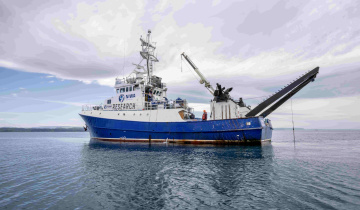NIWA scientists are asking for help from people who have had a long association with East Northland, Hauraki Gulf or Marlborough Sounds.
They are researching the areas where juvenile fish have congregated to find out how these nursery environments have changed over the years and want to learn from people who may have witnessed these changes.
NIWA marine ecologist Dr Mark Morrison says they are particularly interested in populations of juvenile snapper less than 10cm long, in the Hauraki Gulf and East Northland, or small blue cod and tarakihi in the Marlborough Sounds.
“As part of this, we are looking to learn from people who have a long association with these coastal waters, and may have observed such changes.”
Fish history
In addition to interviewing people, the scientists are also keen to gather any historical records that may help in understanding the wider environmental history of the Hauraki Gulf/East Northland and Marlborough Sounds.
As the focus is also on habitat and environmental change, the researchers are interested in changes in coastal waters from the shore out to about 30m deep. Historical photographs, personal field diaries or fishing logs would be particularly valuable in helping to understand how things have changed, Dr Morrison says.
Dr Morrison says the young fish are strongly associated with what’s on the seafloor, especially living habitats. For juvenile snapper these include seagrass meadows, horse mussel beds and sponge gardens. For blue cod it includes bryozoan fields and rubble such as dead shells, and for tarakihi, tube-worm and bryozoan fields.
“Unfortunately all of these habitats have been adversely affected by marine and land-based human activities. This means that they are likely to be less common and of lower quality than ever before.”
How habitats function
People would most likely have noticed areas where the water has become more turbid, where kelp may have disappeared, and where the seafloor has become muddier.
Dr Morrison says the researchers are working from the hypothesis that the loss or reduction of juvenile fish habitats means fewer juvenile fish will make into adult populations.
“Our goal is to identify where and how habitats function and work on increasing the survival rates of small fish. We will use surveys and experiments to learn how the habitats operate, where they are and what threatens their existence.”
A computer model will also be built to enable the researchers to explore “what if” scenarios to help decide on the best management actions for the future.
Getting involved
People willing to participate would be interviewed by a researcher. Nautical charts, pictures and specimens will also be used to help participants identify where different species and habitats are found, and the changes to these and the wider environment. Participants can remain anonymous.
Some of the questions include:
- Where are different juvenile fish habitats found, how common or rare are they, and what species and densities of juvenile fish are found within them?
- How has the abundance of these nursery habitats changed over time? Can we pin down the reasons for any changes? e.g., changes in adjacent land-use, fishing method pressures, general declines in water quality, increased sedimentation?
- What sort of wider environmental changes have been observed? e.g., general declines in water clarity/increases in turbidity, increasing muddiness of the seafloor, loss of kelp forests and horse mussel beds
- What sort of estuarine and/or coastal system changes have been observed over people’s lifetimes?
Anyone willing to participate in the survey can register their details at www.niwa.co.nz/fishsurvey.






